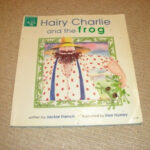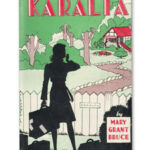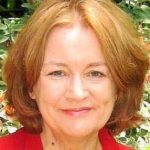Saving the Books That Make Us
Decades ago, when I began writing, most mail I received would be kids’ letters written as assignments from teachers. ‘Our teacher said we had to write to our favourite author. Roal Dahl is dead so I’m writing to you.’
Now after over 30 years of writing for young people, there are emails instead, and often from adults, seeking the books they loved as a child.
 Few books stay in print forever. I have to sadly say, ‘No, I’m afraid I don’t have a spare copy of Hairy Charlie and the Frog – the company that published it has closed. I don’t even have a copy myself.’
Few books stay in print forever. I have to sadly say, ‘No, I’m afraid I don’t have a spare copy of Hairy Charlie and the Frog – the company that published it has closed. I don’t even have a copy myself.’
But there is a place that does have a copy – a magic place that curates and celebrates books and their creation, and where almost every book written for Australian children has a home. It’s the National Centre for Australian Children’s Literature (NCACL) and ironically, as I write this, the place that is ‘home’ for Australian children’s literature desperately needs a new home too, for its collection of generations of Australian books for children, artwork for those books, catalogues, lesson plans, exhibition material, and more.
 I’m perhaps the first generation to have been brought up primarily on Australian children’s books, with only a few forays into Enid Blyton or the Bobbsey Twins. My favourite book – and one that became part of who I am – was Karalta, by Mary Grant Bruce, about a war time refugee who finds a home, and captures an enemy spy.
I’m perhaps the first generation to have been brought up primarily on Australian children’s books, with only a few forays into Enid Blyton or the Bobbsey Twins. My favourite book – and one that became part of who I am – was Karalta, by Mary Grant Bruce, about a war time refugee who finds a home, and captures an enemy spy.
At fifteen I was told to leave home, taking only what I could carry. The rest – the books I loved, and the early books I’d written – were taken to the dump by my mother, to rid the house of any trace of me. I hunted for those loved books for years, desperately wanting their companionship again. I did find a copy of Karalta, but I assumed the others had gone forever. These books had sustained me through terror and through boredom. It was as if friendships had been severed, and I could never find those friends again.
 And then, unexpectedly, during a Children’s Book Council of Australia Conference, I found out that those books and thousands of others had all been living in the city closest to my home, with Belle Alderman at the NCACL. Belle could even tell me the name of ‘the book about the head-hunters of Mer’…I still can’t remember the title, nor the author, but was able to skim read it at the Centre, till it was safely archived again. I am sure Belle would be able to name it and find it again, but it doesn’t matter. I only wanted to meet again.
And then, unexpectedly, during a Children’s Book Council of Australia Conference, I found out that those books and thousands of others had all been living in the city closest to my home, with Belle Alderman at the NCACL. Belle could even tell me the name of ‘the book about the head-hunters of Mer’…I still can’t remember the title, nor the author, but was able to skim read it at the Centre, till it was safely archived again. I am sure Belle would be able to name it and find it again, but it doesn’t matter. I only wanted to meet again.
Books like this one were written by and about Australians – and even if not always politically correct – they helped us grow into a nation who could see beyond our backyard fences into the ‘other Australians’ of this diverse nation. These books are loved, and for that reason alone, deserve to be kept, remembered and cherished.
Years ago I rang our Federal politicians to find out their favourite book as a child. Every single one could answer me in seconds. The books we love as young people are far more deeply important than those we read as adults, partly because if you are five years old, that book will be a larger percentage of your life experience.
The emails I most cherish today are the ones that say, ‘I wouldn’t have become the person I am now without that book.’ The emails I most regret not being able to write are to Ethel Turner and Mary Grant Bruce and so many others, to say, ‘You saved my life. You made me realise I was Australian. Your books made me a writer.’
 The NCACL not only holds my beloved friends, but also my own books, papers and diaries, showing how I became a writer, and developed as a writer over the decades. Similar material is held for many major writers of ‘kids’ lit’ in Australia. Its archive can never be duplicated. It is vital that it is preserved.
The NCACL not only holds my beloved friends, but also my own books, papers and diaries, showing how I became a writer, and developed as a writer over the decades. Similar material is held for many major writers of ‘kids’ lit’ in Australia. Its archive can never be duplicated. It is vital that it is preserved.
The media is mostly concerned with today, or what might happen next week. The NCACL holds our literary history as a nation – who we were, who we are, and always – who we may become.
 Jackie French is an Ambassador of the National Centre for Australian Children’s Literature Inc. Her commitment to the community is extensive. She was the Australian Children’s Laureate for 2014/15 and the 2015 Senior Australian of the Year. She is also an historian, ecologist, dyslexic, and a passionate worker for literacy, the right of all children to be able to read, and the power of books. Jackie’s writing career spans 25 years, 148 wombats, over 140 books, 36 languages, 3,721 bush rats, and over 60 awards in Australia and overseas. Jackie is also the ACT Children’s Week Ambassador, 2011 Federal Literacy Ambassador, patron of Books for Kids, YESS, and joint patron of Monkey Baa Theatre for Young People with Susanne Gervais and Morris Gleitzman. She is also a director of The Wombat Foundation that raises funds for research into the preservation of the endangered northern hairy nosed wombat. Source: Jackie French’s website
Jackie French is an Ambassador of the National Centre for Australian Children’s Literature Inc. Her commitment to the community is extensive. She was the Australian Children’s Laureate for 2014/15 and the 2015 Senior Australian of the Year. She is also an historian, ecologist, dyslexic, and a passionate worker for literacy, the right of all children to be able to read, and the power of books. Jackie’s writing career spans 25 years, 148 wombats, over 140 books, 36 languages, 3,721 bush rats, and over 60 awards in Australia and overseas. Jackie is also the ACT Children’s Week Ambassador, 2011 Federal Literacy Ambassador, patron of Books for Kids, YESS, and joint patron of Monkey Baa Theatre for Young People with Susanne Gervais and Morris Gleitzman. She is also a director of The Wombat Foundation that raises funds for research into the preservation of the endangered northern hairy nosed wombat. Source: Jackie French’s website
See also:
NCACL collection holdings of Jackie French’s books
Artwork by Dee Huxley of Hairy Charlie and the Frog as described in the NCACL Artwork Frameworks
Submission to the Parliamentary Inquiry into Canberra’s National Institutions From the National Centre for Australian
Children’s Literature Inc. 2019 (Note: Some links may have expired since the submission was written.)
Finding aids available:
French, Jackie (2009)
French, Jackie (2013)
Posted by: NCACL | Published: 30 Apr 2025

0 Comments
There are currently no comments, be the first to leave one